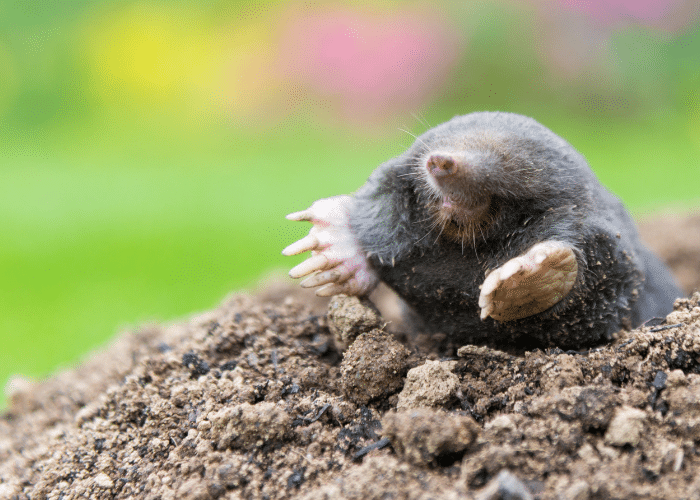
Moles are small mammals that live in underground burrows and are known for their use of tunnels to hunt for food and establish territories. They are prolific diggers with powerful front claws that can reach depths of up to 14 inches. Moles rely on their acute senses and sophisticated communication system to navigate their subterranean world and cooperate with fellow moles.
In this article, we will explore the fascinating behavior of these subterranean creatures and learn more about how they live, hunt, and communicate:
Overview of Mole Behavior
Moles (Talpidae) are small, burrowing mammals that are found throughout most of the Northern Hemisphere. They are best known for their appearance: long, tapered snouts and velvety fur that covers their entire body.
Despite their tiny size, these solitary creatures play a vital role in maintaining healthy soil by aerating it and removing organic material like expired insects and worms. As they dig through the soil, they leave behind deep tunnel structures that can help increase drainage efficiency and promote the growth of grass or other vegetation.
It is widely believed that moles live alone and hunt alone, but studies have shown that they aggregate in certain areas of their habitat to feed and rest; sometimes there will be as many as twenty individuals congregated together in an area at one time! They also seem to rely on other species for communication purposes; when a mole is disturbed by an intruder or predator, it will emit short vocalizations called “drumming” which can attract other moles from nearby tunnels to investigate the disturbance.
In addition to avoiding predators through these behaviors, moles have evolved a wide variety of ways to locate food underground – from tactile search methods such as running their snouts along the soil surface to passive scent-based methods where they simply let prey come close enough for them to grab it with their powerful front claws. Foraging also seems to occur primarily during periods of low light or darkness; this allows them to avoid disrupting everyday activities like gardening or lawn maintenance due to nocturnal feeding habits.
Habitat

Moles live in a wide range of habitats such as grasslands, pastures, cultivated fields, foothills and woodland edges. Moles primarily live underground, in subterranean tunnel systems that they dig themselves. These tunnels can range from just a few inches below the soil surface to several feet down. Under ideal conditions, moles can dig up to 18 feet per hour and build complex tunnel systems with ridges and chambers.
Preferred Habitats
The Eastern mole lives in many areas of eastern North America. Its preferred habitats include lawns, meadows and garden beds. They will also inhabit light woodland areas, marshes and wet hayfields. The mole prefers moist soil that is easy to tunnel through. They usually reside no more than 1 foot below the ground’s surface.
The Western mole is found in parts of the U.S., Canada, and Mexico. It typically lives in forested areas with a loose sandy or loamy soil, but sometimes it can be found near agricultural land or croplands with a porous soil type. In some regions they live high up in hillocks in an area void of trees called pumice lands, which have become common due to volcanic activity.
The star-nosed mole resides primarily in marshy and wetland environments throughout much of eastern Canada and the northeastern United States but have been seen as far south as South Carolina and Georgia. They prefer shallow waters with substantial vegetation for foraging activities during times when the water level recedes during particular seasons such as spring and autumn close to seasonal creeks or streams that create sand bars near their entry points into freshwater rivers or wetlands such as swamps, backwaters and floodplains.
Adaptations to Survive Underground
Moles are among the most mysterious and elusive creatures in the world because of their subterranean lifestyle. Moles are small mammals that spend most of their time burrowing underground, living almost exclusively beneath the surface of the soil. They have adapted a number of unique physical characteristics and behaviors to survive in this hostile environment.
To dig underground quickly and efficiently, moles have stocky bodies, muscular shoulders for pushing soil, small eyes and ears that prevent dirt from getting in, sharp claws for gripping and scooping, large front feet to push against, elongated snouts to find food particles hidden in the soil, muscular hands with short nails to dig through even hard-packed material, and flexible hips that enable them to contort their bodies while they travel.
In addition to their physical traits designed for better mobility beneath the earth’s surface, moles also employ tactical strategies such as leaving warning signals when they detect an intruder or predator. These warning signals include shaking soil particles over their tunnel system or making noise by stomping on the floor.
This fascinating species uses sound waves as well as taste and smell cues as communication means with each other throughout their tunnels. Moreover, moles have fur that amplifies soundwaves so they can hear clearly even within damp environments; it has also been conjectured that sensitive nerve endings around their noses allow them a greater awareness of scent than in aboveground animals.
To survive under such harsh conditions beneath the earth’s surface moles rely on evolving adaptations like these—allowing them to remain largely mysterious while hunting around our feet with unparalleled ease.
Diet
Moles primarily feed on earthworms, grubs, and other small invertebrates. In addition, they may supplement their diet with a variety of insects such as beetles, caterpillars, and grasshoppers. They can also eat small mammals, amphibians, and reptiles.
The dietary preferences of moles may vary from region to region, as well as from season to season.
What Do Moles Eat?
Moles are small mammals that largely make their home underground where they feed on a variety of subterranean insects, worms, and grubs. Moles have specialized anatomical features including keen senses of smell and hearing to assist them in the search for food. Their eyesight is poor due to their life spent underground in tunnels, but they have robust sense of touch which helps them explore their tunneled habitats and find food.
Moles primarily feed on earthworms that live in the soil but can also consume other insects, larvae, snail or slugs. They dig shallow tunnels for foraging just a few centimeters underground that connect to deeper transportation tunnels which allow them to travel large distances in search of food. The shallow surface tunnels have multiple entry points and provide an attractive environment for earthworms which moles hunt as their main source of sustenance.
Moles can eat up to 50 percent of their own body weight everyday and do so through consuming both invertebrates they come across while digging as well as larger meals brought back from longer expeditions below ground. By analyzing the stomach contents of wild moles it has been estimated that 90-99 percent by dry weight comes from invertebrates such as insects, worms and grubs consumed during foraging trips below the surface or stored during hibernation periods throughout the year. Although omnivorous Cape golden moles have been observed eating plant matter, this is rare amongst other species that largely eat protein rich animal sources found within soil ecosystems like earthworms, beetles and larvae.
Hunting Behavior
Moles are solitary animals with a well-defined home range and a wide radius of hunting outside that range. They hunt for earthworms, grubs, and newly hatched insects underground in their burrows, where they are also capable of finding pocket gophers and other small mammals.
Moles possess some unique physical adaptations for hunting in the dark, beneath the surface of the soil:
- Large front feet with long claws adapted for digging.
- Special sensory cells located around its snout called Eimer’s organs to detect potential prey.
- Powerful front legs to dig towards its prey.
- Sensitive ears to detect sound waves produced by a moving creature near it.
- Excellent sense of smell that allows it to locate not just food items but also other moles during mating season or when establishing territories.
With these impressive adaptations moles can locate prey quickly and efficiently while moving through their environment without making a sound.
Communication

One fascinating aspect of mole behavior is how they communicate with each other. Moles use a combination of physical and vocal communication to signal to their peers what is happening in their burrows. Studies have shown that communication is vital for moles to build and maintain their burrows and to find food.
In this section, we will explore the different ways in which moles communicate with each other underground:
Vocalizations
Vocalizations are a key form of interpersonal communication between humans. They involve the use of speech, verbal utterances and other non-verbal sounds such as laughter and crying. It is this type of communication that allows us to convey our thoughts, ideas, beliefs and emotions to another person.
Vocalized communication includes both verbal and non-verbal components. Verbal vocalizations involve the use of words to communicate with others while non-verbal vocalizations involve the use of sounds or musical tones that communicate without words.
The spoken language can be divided into five different categories:
- Prosody (the rhythm and melody of a person’s voice);
- Lexicon (vocabulary);
- Syntax (grammar structures);
- Morphology (word forms) and
- Semantics (meaning).
Non-verbal vocalization may include vocal inflections, pitch, intonation, tone, volume and pauses. Non-verbal vocalization also involves body language such as facial expressions and gestures which act as powerful means of communicating feelings, emotions and unspoken messages. In addition to body language there are also a variety of paralinguistic devices such as whispering or laughing which serve to reinforce verbal messages by adding emphasis or context.
Overall vocalizations play an important role in our daily lives helping us to connect with others on an emotional level as well as improve our communicative skills. In order for successful communication it is important for communicators to be aware not only of their own vocal choices but also how they interpret those used by other people in different contexts.
Scent Marking
When animals communicate with each other, they use a range of methods, including sound and visual cues. One such method is scent marking, a behavior used by mammals to identify individuals, emphasize social status and even mark their territory.
Scent marking is done primarily by releasing pheromones from glands located in the anal or head region of an animal. These chemicals are picked up by members of the same species and can contain important information such as age, gender or reproductive status.
The scent marks can be deposited on a variety of surfaces including other animals, plants and objects in the environment. Animals may also detect them via gustatory or tactile contact. Common techniques for scent marking include:
- Spraying urine or feces onto a surface
- Rubbing the body against it (as cats do)
- Depositing secretions from glands located in the feet (tracked scents)
Each method results in different behavioural responses among animals of the same species. For instance, when there is competition between two males over access to resources or mates they may use exaggerated scent marking to compete for dominance over each other’s territories and increase their chances of success. In contrast, females may utilize more subtle forms of marking to maintain friendly relations within her social circle and retain respect among her peers.
Overall there are immense benefits associated with this fascinating display of communication –from increased safety to better mating opportunities –but it is something that is still not fully understood by humans at this point in time.
Reproduction
Moles use the tunnels they create to communicate, hunt, and reproduce. Reproduction is key to the survival of the species and it is important to understand the process of mole reproduction.
Moles reach reproductive maturity between 4 and 9 months of age. The mating process begins in late winter and, in some areas, may continue until mid-summer. Reproduction involves scent marking and territoriality, which can be observed between adult moles.
Mating Habits
Moles mate twice each year between February and August. The amount of mating activity is dependent on geographic location, with the Southern mole breeding earlier than its Northern cousin. Most pregnancies last 30 – 40 days, with an average of two to five young being born in April and May, but that may vary depending on the location. Pups reach full maturity between mid-July and early September, when they venture out on their own.
On average, female moles produce one litter per year in temperate regions, however if environmental conditions are suitable for foraging and food availability high enough or mating sites sheltered enough, she may have a second litter before winter sets in.
Nest Building
Moles have a complex reproduction process that involves nesting and tunneling together for protection. Generally, the female mole will build a nest out of dried grasses, leaves, and other materials she finds underground. This nest is typically located in a tunnel system near enough to the surface where the entrance to the nest can be reached. After building their nest, male moles will attempt to attract female moles by making a loud clicking noise and rubbing against them. If two moles mate successfully, the female will give birth to two to six young moles inside the nest.
Once these young are born into the underground world they must quickly learn how to hunt and survive because they are ready to live in as little as two weeks. In order to make sure they thrive, both parents stay close by while they learn how to build tunnels, find food sources such as earthworms and insects, and protect themselves from predators by quickly escaping into their tunnels when danger arises. It is said that before leaving its parent’s side one mole may remain with them for up to four months after being born before venturing off on its own.
Conclusion
Our exploration of mole behavior has provided us with an in-depth understanding of their activities in the wild. It is clear that moles are highly adapted to life underground and they have remarkable survival skills that allow them to excel in this environment. They hunt using their strong sense of smell, communicate using a variety of vocalizations and scents, and can detect delicate vibrations caused by prey to locate food sources. Moles mate during the late spring – early summer months and can become reproductive at just six to seven weeks old.
In terms of development, moles spend two weeks in the embryonic stage before being born blind and hairless. While not visible aboveground, these creatures are masters of subterranean living and highly reliant on a stable food source within range of their tunnels.
While some species do resort to eating plants as well as small insects, most moles feed on earthworms as their main source of sustenance. Financially dependent on earthworms for essential nutrients despite extreme territorial constraints below ground, this species has learned to thrive under these conditions nonetheless. With an impressive set of search strategies, intricate channeling systems for ventilation and efficient movement underground, it is no wonder that this amazing animal is a model for ingenuity and resourceful adaptability.
Frequently Asked Questions
Q: How do moles hunt for food?
A: Moles use their powerful front claws to dig into the ground in search of food. They mostly feed on earthworms and insect larvae, but will also eat grubs, spiders, and other small invertebrates.
Q: How do moles communicate?
A: Moles communicate through a series of vocalizations, including grunts, squeals, and growls. They also communicate through a series of physical signs, such as raising their heads or waving their front paws.
Q: How do moles live?
A: Moles live in underground tunnels and chambers that they dig with their powerful front claws. They spend most of their time in these tunnels, but can also be found above ground in search of food.





